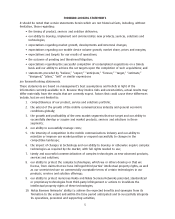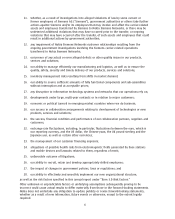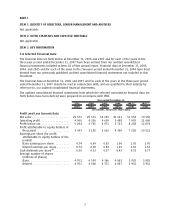Nokia 2007 Annual Report Download - page 16
Download and view the complete annual report
Please find page 16 of the 2007 Nokia annual report below. You can navigate through the pages in the report by either clicking on the pages listed below, or by using the keyword search tool below to find specific information within the annual report.customer demand, or fail to do so on a timely basis, this may have a material adverse effect
on our business and results of operations.
In order to succeed in our markets, we believe that we must develop or otherwise acquire complex,
evolving technologies to use in our business. However, the development and use of new
technologies, applications and technology platforms for our mobile devices, services and software and
networks infrastructure products involve time, substantial costs and risks, both within and outside of
our control. We must also be able to convert these complex technologies into affordable and usable
products, services and solutions. This is true regardless of whether we develop these technologies
internally, acquire or invest in other companies with these technologies or collaborate with third
parties on the development of these technologies. In addition, we seek to protect our technology
investments with intellectual property rights. When doing this, our business is influenced by the
regulatory and legal environments’ approach to intellectual property rights, including the scope and
degree of patent and copyright protection as well as copyright levies which vary country by country.
The technologies, functionalities, features and services on which we choose to focus may not achieve
as broad or timely customer acceptance as we expect. This may result from numerous factors,
including the availability of more attractive alternatives and a lack of sufficient compatibility with
other existing technologies, products, services and solutions or regulators’ decisions. Additionally,
even if we do select the technologies, functionalities, features and services that customers ultimately
want, we or the companies that work with us may not be able to bring them to the market at the
right time. We may also face difficulties accessing the technologies preferred by our current and
potential customers, or at prices acceptable to them.
Our products, services and solutions include increasingly complex technology involving numerous new
Nokia and Nokia Siemens Networks patented, standardized, or proprietary technologies, as well as
some developed or licensed to us by third parties. There can be no assurance that the technologies,
with full rights needed to be used in our business, will be available or available on commercially
acceptable terms, on a timely basis.
Furthermore, as a result of ongoing technological developments, our products, services and solutions
are increasingly used together with hardware, software or service components that have been
developed by third parties, whether or not we have authorized their use with our products, services
and solutions. However, such components, such as batteries or software applications, may not be
compatible with our products, services and solutions and may not meet our and our customers’
quality, safety, security or other standards. As well, certain components or layers that may be used
with our products may enable our products, services and solutions to be used for objectionable
purposes, such as to transfer content that might be illegal, hateful or derogatory. The use of our
products, services and solutions with incompatible or otherwise substandard hardware, software or
software components, or for purposes that are inappropriate, is largely outside of our control and
could harm the Nokia brand.
Our products, services and solutions include increasingly complex technologies, some of which
have been developed by us or licensed to us by certain third parties. As a consequence,
evaluating the rights related to the technologies we use or intend to use is more and more
challenging, and we expect increasingly to face claims that we have infringed third parties’
intellectual property rights. The use of these technologies may also result in increased
licensing costs for us, restrictions on our ability to use certain technologies in our products,
services and solution offerings, and/or costly and timeconsuming litigation, which could have
a material adverse effect on our business and results of operations.
Our products, services and solutions include increasingly complex technologies, some of which have
been developed by us or licensed to us by third parties. As the amount of such proprietary
technologies and the number of parties claiming intellectual property rights continues to increase,
even within individual products, as the range of our products, services and solutions becomes more
diversified and we enter new businesses, and as the complexity of the technology increases, the
15
























